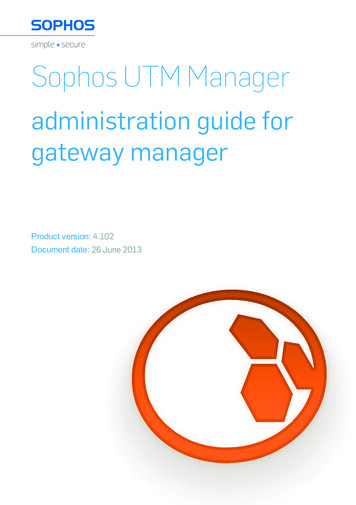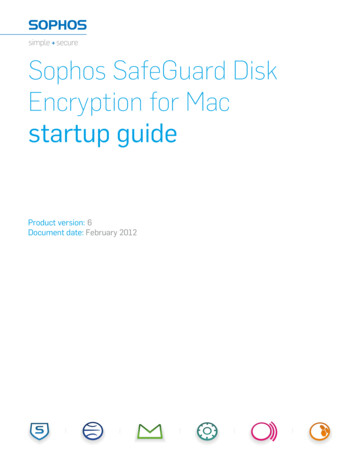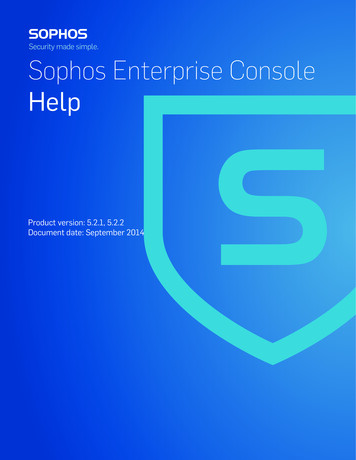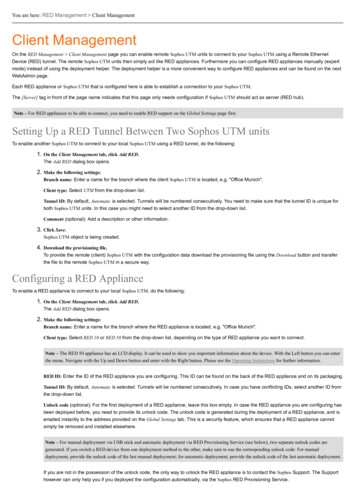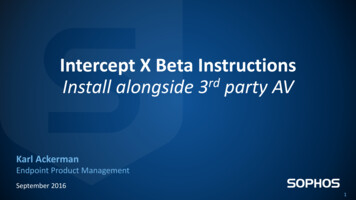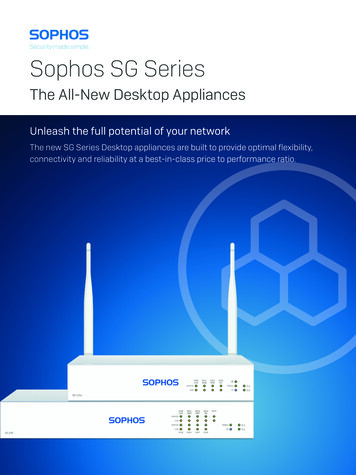
Transcription
SOPHOS 2021THREAT REPORTNavigating cybersecurity in an uncertain worldBy SophosLabs, Sophos Managed Threat Response,Sophos Rapid Response, Sophos AI, Cloud Security
SOPHOS 2021 THREAT REPORTCONTENTSTHE POWER OF SHARING2EXECUTIVE SUMMARY3THE FUTURE OF RANSOMWARE5Data theft creates a secondary extortion market5Ransoms rise as attacks increase7Days-in-the-life of a ransomware rapid responder9EVERYDAY THREATS TO ENTERPRISES – CANARIES IN THE COAL MINE10Attacks targeting Windows & Linux servers10Underestimate “commodity” malware at your peril12Delivery mechanisms14Information security: A 20-year retrospective18COVID-19 AS A FORCE-MULTIPLIER IN ATTACKS20Home is the new perimeter20Crimeware as a service21Spam, scams, and broken promises22Remote work raises the importance of secure cloud computing25What the CCTC means for a rapid response to large scale threats27NOT LETTING YOUR GUARD DOWN: THREATS VIA NONTRADITIONAL PLATFORMS28Android Joker malware growing in volume28Ads & PUAs increasingly indistinguishable from malware29Using your own strengths against you: Criminal abuse of security tools31Digital epidemiology33November 20201
SOPHOS 2021 THREAT REPORTTHE POWER OF SHARINGJoe Levy, CTO, Sophos“If you want to go quickly, go alone,but if you want to go far, go together.”This African proverb couldn’t ring truer for the cybersecurity industry. By working collectively, with a strongsense of teamwork, we can achieve far more than fighting cybercrime as individual vendors.But, only by improving our approach and sharing threat intelligence more comprehensively, and byexpanding the pool of participants who contribute to (and benefit from) this sharing and collaboration, willcybersecurity vendors continue to drive up costs for attackers, and make lasting, impactful change.In the spirit of that approach to working together, in 2017 Sophos joined the Cyber Threat Alliance, anorganization dedicated to breaking down the barriers that, for years, stymied any chance for competitorsin the information security industry to collaborate with one another. The CTA has succeeded far beyond itsinitial mandate to serve as a repository of shared threat intelligence and a place to resolve differences, andhas become a sort of UN to the cybersecurity industry.Through our partnership with the CTA, Sophos can better protect our customers, thanks to the earlywarnings and data exchange between vendors, made possible by the alliance. Sophos also shares theburden of protecting the other vendors’ customers by contributing our own threat intel.In March 2020, as lockdowns to contain the spread of COVID-19 were implemented rapidly across theworld, Sophos chief scientist, Joshua Saxe put out a call on Twitter. Appalled that criminal groups werestarting to incorporate references to COVID-19 into a range of crime campaigns, information securityanalysts – more than 4,000 of them – banded together in a collective show of defiance and formed theCOVID-19 Cyber Threat Coalition (CCTC) in a Slack channel created that same day. This channel is buildingan enduring “commons” for the community to leverage in times of crisis, and is close to achieving not-forprofit status under the auspices of the CTA.Ultimately, these stories about sharing threat intelligence tell us about more than just the organizationsthemselves. As another parable—that of the blind man and the elephant—teaches us, no one vendor canprovide comprehensive or absolute truth through their subjective experiences alone. The true shape ofcomplicated things emerges from the union of our experiences. These collaborative initiatives protectedmillions of people from becoming victims of cybercrime, but that alone wasn’t why they were successful.They thrived because the core motivation of their members and founders has been to, first, protect anyonewho might be in harm’s way from harm. There was no profit motive, just a desire to defend those in need,while it seemed like the wolves were at the door.This proves the model is correct, and bridges critical gaps in coverage none of us alone could generate, butwe can do more with it. As an industry, we may in the future want to consider sharing machine learningmodels, or training datasets, just as we share block lists or Yara rules today. We could also strengthenand contribute to emerging standards like STIX and the ATT&CK framework. And we could participate inindustry-specific ISACs and ISAOs.The future will be more connected, and we’ll all be better off (and better protected) for it.November 20202
SOPHOS 2021 THREAT REPORTEXECUTIVE SUMMARYThe Sophos 2021 Threat Report covers topic areas into which Sophos has gained insight from the workover the past 12 months by SophosLabs on malware and spam analysis, and by the Sophos RapidResponse, Cloud Security, and Data Science teams. These aspects of our daily work protecting customersprovide insight into the threat landscape that can guide incident responders and IT security professionalson where they should direct their efforts to defend networks and endpoints in the coming year.We've segmented the report into four main parts: Discussion of how ransomware has transformed itself,and where this threat is headed; analysis of the most common attacks large organizations face, and whythese metaphorical canaries in the coal mine remain significant threats; how the emergence of a globalpandemic affected information security in 2020; and a survey of the scope of attacks targeting platformsnot traditionally considered part of an enterprise's attack surface.To summarize the key takeaways from the report:RansomwareÌ Ransomware threat actors continue to innovate both their technology and their criminal modusoperandi at an accelerating paceÌ More ransomware groups now engage in data theft so they may threaten targets with extortion over therelease of sensitive private dataÌ As ransom groups put more effort into active attacks against larger organizations, the ransoms theydemand have risen precipitouslyÌ Further, distinct threat actor groups that engage in ransomware attacks appear to be collaboratingmore closely with their peers in the criminal underground, behaving more like cybercrime cartels thanindependent groupsÌ Ransomware attacks that previously took weeks or days now may only require hours to complete'Everyday' threatsÌ Server platforms running both Windows and Linux have been heavily targeted for attack, and leveragedto attack organizations from withinÌ Common services like RDP and VPN concentrators remain a focus for attack on the network perimeter,and threat actors also use RDP to move laterally within breached networksÌ Even low-end "commodity" malware can lead to major breaches, as more malware families branch outinto becoming "content distribution networks" for other malwareÌ A lack of attention to one or more aspects of basic security hygiene has been found to be at the rootcause of many of the most damaging attacks we've investigatedNovember 20203
SOPHOS 2021 THREAT REPORTCOVID-19Ì Working from home presents new challenges, expanding an organization's security perimeter tothousands of home networks protected by widely varying levels of securityÌ Cloud computing has successfully borne the brunt of a lot of enterprise needs for secure computingenvironments, yet still has its own challenges unique from those in a traditional enterprise networkÌ Threat actors have attempted to launder their reputations making promises not to target organizationsinvolved in life-saving health operations, but later reneged on those promisesÌ Criminal enterprises have branched out into a service economy that eases new criminals into the foldÌ Cybersecurity professionals from around the world self-organized in 2020 into a rapid reaction forceto combat threats that leverage the social engineering potential of anything relating to the novelCoronavirusNontraditional platformsÌ Attackers now routinely take advantage of the wealth of "red team" tools and utilities pioneered bypenetration testers in live, active attacksÌ Despite efforts on the part of operators of mobile platforms to monitor apps for malicious code,attackers continue to work around the edges, developing techniques to bypass these code scansÌ Software classified in an earlier era as "potentially unwanted" because it delivered a plethora ofadvertisements (but was otherwise not malicious) has been engaging in tactics that are increasinglyindistinguishable from overt malwareÌ Data scientists have applied approaches borrowed from the world of biological epidemiology to spamattacks and malware payloads, as a method to bridge gaps in detectionNovember 20204
SOPHOS 2021 THREAT REPORTTHE FUTURE OF RANSOMWARERansomware attacks launched throughout 2020 magnified the suffering of an already wary population.As the pandemic ravaged lives and livelihoods, so did a host of ransomware families, whose efforts did notstop targeting the health and education sectors, even as hospitals became COVID-19 battlegrounds andschools struggled to invent an entirely new way to teach children through March and beyond.You can’t raise enough in a bake sale during a pandemic to pay a ransom, but some schools managed torecover from attacks that appeared targeted at the first day of school, by keeping secure backups.Ransomware operators pioneered new ways to evade endpoint security products, spread rapidly, and evencame up with a solution to the problem (from their perspective) of targeted individuals or companies havinggood backups, securely stored where the ransomware couldn’t harm them.But what appeared to be a wide variety of ransomware may not be as wide as it seems. As time went on,and we investigated an increasing number of attacks, Sophos analysts discovered that some ransomwarecode appeared to have been shared across families, and some of the ransomware groups appeared to workin collaboration more than in competition with one another.Given all this, it’s hard to make any kind of reliable prediction of what ransomware criminals will do next.Ransomware creators and operators have burned a lot of time working on defenses against endpointsecurity products. We counter their countermeasures. They show creativity and versatility in devising newtactics; we show tenacity in studying what they do and finding clever ways to stop them.Data theft creates a secondary extortion marketUntil this year, conventional wisdom among security companies that had any experience at all withransomware ran quite uniformly: Lock down obvious ingress methods, such as internet-facing RDP ports;keep good offline backups; and deal with infections of small, innocuous malware such as Dridex or Emotetquickly, before they can deliver the killing payload.Several high-profile ransom attacks, for instance, against school districts across the US, failed at least inpart because the IT managers had maintained an unaffected backup of critical data.As a countermeasure to their victims’ preparedness, several ransomware families picked up on a sidehustle designed to increase pressure on their victims to pay the ransom – even if every backup withessential data was safe. Not only would they hold the machines hostage, but they would steal the data onthose machines and threaten to release it to the world if the targets fail to pay a bounty.Over the past half year, Sophos analysts observed that ransomware adversaries have settled on a common(and slowly growing) toolset they use to exfiltrate data from a victim’s network. This toolset of wellknown, legitimate utilities anyone might have won’t be detected by endpoint security products. The list ofransomware families that engage in this practice continues to grow, and now includes Doppelpaymer, REvil,Clop, DarkSide, Netwalker, Ragnar Locker, and Conti, among many others. The attackers operate “leaks”sites, where they publicize what data they’ve stolen; REvil allows anyone to buy the data from them rightfrom its website.November 20205
SOPHOS 2021 THREAT REPORTThe criminals use the toolset to copy sensitive internal information, compress it into an archive, andtransfer it out of the network – and out of reach of the victim. These are some of the tools we’ve seen used,so far:Ì Total Commander (file manager with built-in FTP Client)Ì 7zip (Archive creation software)Ì WinRAR (Archive creation software)Ì psftp (PuTTY’s SFTP client)Ì Windows cURLWhen it comes to data theft, the attackers are far less picky and exfiltrate entire folders, regardless of thefile types that are contained within. (Ransomware typically prioritizes the encryption portion of the attack tokey file types and excludes many others.)Size doesn’t matter. They don’t seem to care about the amount of data targeted for exfiltration. Directorystructures are unique to each business, and some file types can be compressed better than others. Wehave seen as little as 5 GB, and as much as 400 GB, of compressed data being stolen from a victim prior todeployment of the ransomware.Fiig.1. In October, 2020, the Doppelpaymer ransomware leaks page revealed that the attackers had struck the networks of Hall County, Georgia. The leakincluded a reference to a file called “elections” which included sample ballot proofs for the state primary elections in 2020 and lists of poll workers and theirphone numbers from the 2018 elections, among other sensitive files. The Associated Press reported that the ransomware encrypted the signature verificationdatabase the county uses to validate ballots. Source: SophosLabs.November 20206
SOPHOS 2021 THREAT REPORTThe criminals typically send the exfiltrated data to legitimate cloud storage services, which make thisactivity harder to spot, since these are common, ordinary network traffic destinations. For attackers, thefollowing three cloud storage services have been the most popular go-to for storing exfiltrated data:Ì Google DriveÌ Amazon S3 (Simple Storage Service)Ì Mega.nzÌ Private FTP serversIn a final act of destruction, ransomware attackers increasingly hunt for the local servers that containbackups of critical data; when found, they delete (or independently encrypt) these backups just before thenetwork-wide encryption attack.It’s more important than ever to store a backup of key data offline. If they can find it, the ransomwarecriminals will destroy it.Ransoms rise as attacks increaseIt’s hard to believe that just two years ago, Sophos analysts marveled at the 6 million haul brought inby the operators of the ransomware known as SamSam. In an attack Sophos responded to in 2020, theransomware operators opened their negotiations at a dollar amount of more than twice what the SamSamgang earned in 32 months of operation.Ransomware comes in weight classes, now: heavyweights that attack large enterprise networks,welterweights that target civil society (public safety and local government) and small-to-mediumbusinesses, and featherweights that target individual computers and home users. While earning thedubious distinction of being the heaviest heavyweight sounds impressive, it isn’t fair to compare highransom demands to those that originate from the lower end of the ransomware spectrum.Sophos has a dedicated team that investigates, and often works with the targets of, ransomware attacks.The team can forensically reconstruct the events of an attack after the fact, and sometimes disrupt attackswhile they’re still in progress. The Sophos Rapid Response team gets involved in cases when there’s achance to stop or limit the harm, but sometimes the attack happens so fast, there’s nothing it can do, andthe target must then decide whether or not to pay the ransom, at which point, Sophos is no longer involved.November 20207
SOPHOS 2021 THREAT REPORTThat’s where companies like Coveware come in. The company represents ransomware targets, as ahigh-stakes negotiator with their attackers. Coveware’s CTO Alex Holdtman confirmed our suspicion, thatransomware heavyweights are the primary driving factor in the demand for sky-high ransoms.Average ransom payouts, quarterlyQ4 2019Q1 2020Q2 2020Q3 2020 84,116.00 111,605.17 178,254.19 233,817.30Fig.2. The average ransom demand has risen 21% in the past quarter and has nearly tripled over the past year. Source: Coveware.In just the past quarter, the average ransom payout has risen by 21%, but Coveware believes the averagescan be skewed by just one or two very large ransom attacks. The average ransom payout in the justcompleted quarter is now the equivalent of 233,817.30, payable in cryptocurrency. A year ago, the averagepayout was 84,116.Ransomware threat actors understand how expensive downtime can be, and have been testing the upperlimit of what they can extract in a ransom attack.Several ransomware families have taken up extortion as a side-hustle to help close the deal. As mentionedearlier in our report, groups such as Netwalker and others are using this tactic. That way, even if the targetof the attack has perfectly recoverable backups of their data, they may still be forced to pay in the hopes theransomware criminals don’t publish their internal information to the world.At the lower end of the ransomware spectrum, demands have been increasing, but Holdtman says they’renowhere near the big fish. There are a lot of small businesses and individuals that get hit, but for them theransom demands have remained relatively flat.November 20208
SOPHOS 2021 THREAT REPORTDays-in-the-life of a ransomware rapid responderWhen an organization was targeted by the then still active Maze ransomware, it turned to the Sophos Rapid Responseteam. We investigated and actively countered the attack while it was still in progress. What follows is a day-by-daysummary of the attack as it unfolded.Before Day 1At some point before the attack becomes active, the operatorscompromise a computer on the target’s network.This computer is then used as a ‘beachhead’ in the network. Onmultiple occasions, the attacker will connect from here to othercomputers using the Remote Desktop Protocol (RDP).Day 1The first evidence of malicious activity appears when a CobaltStrike SMB beacon is installed as a service on an unprotectedDomain Controller (DC). The attackers are able to control the DCfrom the previously compromised computer by exploiting a DomainAdmin account with a weak password.Day 2The attackers create, execute, and then delete a series ofscheduled tasks and batch scripts. From the evidence seen byinvestigators, the tasks were similar to a technique used later todeploy the ransomware attacks. It is possible that the attackers aretesting the method they plan to use.Using the compromised Domain Admin account and RDP access,the attackers move laterally across the network to other criticalservers.They use the legitimate network scanning tool, Advanced IPScanner to start mapping out the network and make lists of IPaddresses that would later have the ransomware deployed to them.The attackers create a separate list of IP addresses belonging tothe computers used by the target’s IT administrators.Next, the attackers use the Microsoft tool ntdsutil to dump ActiveDirectory’s hashed credential database.Day 6A Sunday. The first Maze ransomware attack is launched, using acompromised Domain Admin account and the lists of IP addressesthat have been identified. Over 700 computers are targeted inthe attack, which is promptly detected and blocked by security.Either the attackers don’t realize the attack has been prevented,or they hope that having the stolen data to hold against the victimis enough, because this is the moment when they issue a ransomdemand for 15 million.Day 7The security team installs additional security and engages 24/7threat monitoring. The incident response investigation begins,quickly identifying the compromised admin account, discoveringseveral malicious files, and blocking communication between theattacker and the infected machines.Day 8Further tools and techniques used by the attackers are discovered,as well as evidence relating to the exfiltration of data. More files andaccounts are blocked.Day 9Despite the defensive activity, the attackers maintain their accessto the network and a different compromised account, and launcha second attack. This attack is similar to the first one: executecommands on a DC, looping through the lists of IP addressescontained in txt files.The attack is quickly identified. The ransomware is detectedautomatically and both the compromised account and themalware payload is disabled and deleted. No files are encrypted.The attackers execute various WMI commands to collectinformation about compromised machines, and then theirattention turns to the exfiltration of data: They identify a file serverand, using the compromised Domain Admin account, access itremotely over RDP. They start compressing folders located on it.Cleary not wanting to give up, the attackers try again. The thirdattempt comes just a few hours after the second attack.The attackers move the archives to the domain controller, thentry to install the cloud storage application Mega on the DC. This isblocked by security, so they switch to using the web-based versioninstead and upload the compressed files.The Maze attackers take a different approach, deploying a full copyof a virtual machine (VM) and a VirtualBox hypervisor installer, anattack detailed on SophosLabs Uncut in September, 2020.Day 3Exfiltration of data to Mega continues throughout the day.Day 4 and 5No malicious activity is observed during this period. In previousincidents, we’ve observed ransomware attackers waiting to springthe attack over a weekend or holiday, when the IT security teamisn’t working or paying close attention to what is happening in thenetwork.November 2020By now they seem to be growing desperate as this attack targets asingle computer. This is the main file server that the exfiltrated datahad been taken from.The outcome of the third attempt is the same as before: theSophos Rapid Response team detected and thwarted the attack,with no encryption of files. The team helped the customer lock outthe criminal group, and the attackers ceased being able to pressthe attack further.9
SOPHOS 2021 THREAT REPORTEVERYDAY THREATS TO ENTERPRISES – CANARIES INTHE COAL MINEIf everything you know about cyberattacks comes from news reports, you could be forgiven for thinkingthe sky was falling. Attacks that target large organizations happen every day, but they’re not all the kind ofblack swan events, like a major data breach, that can send a company’s fortunes (or stock price) tumblingand generate bad publicity. Many attacks are far more mundane, involving malware the SophosLabs teamtracks in a sort of “Most Wanted” list of “The Usual Suspects”.But though these attacks, and some of the malware they deliver, are well understood and easily contained,every attack carries with it the potential to get far worse if it isn’t dealt with speedily and effectively. To carrythe bird metaphor forward, these routine, everyday attacks represent canaries in the coal mine, an earlyindication of a toxic presence that could quickly spiral out of control.Attacks targeting Windows & Linux serversWhile the vast majority of security incidents we responded to in 2020 involved desktop or laptop computersrunning variations of Windows, we saw a steady increase in attacks on both Windows and non-Windowsservers. In general, servers have long been attractive attack targets for a variety of reasons: They often runfor long periods unattended or unmonitored; servers often carry more CPU and memory capacity thanindividual laptops; and servers may occupy a privileged space on the network, often having access to themost sensitive and valuable data in an organization’s operation. This makes them an attractive foothold fora persistent attacker. These characteristics won’t change in 2021 and Sophos anticipates the volume ofattacks targeting servers will continue to increase.The majority of attacks targeting servers fit one of three profiles – ransomware, cryptominers and dataexfiltration – each of which has a corresponding, distinct set of tactics and techniques the attackersemploy. Best practices for server admins is to avoid running conventional desktop apps, like email clients ora web browser, from the server as a safeguard against infections, so attacks targeting servers necessarilyrequire a shift in tactics.Internet-facing servers running Windows receive a never-ending barrage of RDP brute-forcing attempts, anattack tactic that, for at least the past three years, has been most often associated with (and predictive of)ransomware attacks. The Sophos Rapid Response team frequently finds that the root cause of ransomwareattacks it investigates involve an initial access to the target’s network by means of RDP, and then the use ofthose machines to gain a foothold within the network and take control of DC servers, from which they canmount the rest of the attack.By contrast, cryptojacking attacks tend to target a wider range of vulnerabilities in Windows, and inapplications that normally run on server hardware, such as database software.For instance, one method used by the Lemon Duck cryptominer involves a brute-force attack againstinternet-facing servers running Microsoft SQL Server. Once the attackers guess the correct databasepassword, they use the database itself to reassemble the cryptojacker payload, write it out to the server’sfile system, and execute it. The infected machine then attempts to exploit the EternalBlue and/orSMBGhost vulnerabilities in a bid to spread the cryptojacker.November 202010
SOPHOS 2021 THREAT REPORTLemon Duck is an equal-opportunity attacker, and can infect Linux servers. The malware attempts tobrute-force SSH passwords taken from a relatively small list. If successful, the attackers load maliciousshellcode, which then establishes persistence by taking advantage of loopholes in a service called Redis.The cryptojacker can also conceal itself by executing the commands to start itself from within Hadoopclusters.Fig.3. One of the more prolific cryptojackers, called MyKings, distributed the components responsible for installing the botnet (highlighted in green) inside a Ziparchive along with several of the exploits leaked from the NSA by the Shadow Brokers. Source: SophosLabs.Occasionally, attackers target servers because, rather than a quick payday or a steady trickle ofcryptocurrency, they want to steal data of value stored on them. In 2020, Sophos discovered an attackertargeting Linux servers using malware we called Cloud Snooper. The servers in question were hosted in acloud computing cluster, and evaded detection by inventing a clever message-relay system, piggybackingtheir command-and-control messages on routine HTTP connections.Fig.4. A “wolf in sheep’s clothing” metaphor illustration of how the Cloud Snooper APT malware concealed its commands and exfiltrated data in the guise ofconventional HTTP requests and responses, with the help of a tool that monitored network traffic and rewrote TCP/IP packets in real time. Source: SophosLabs.Server admins have not, historically, installed endpoint protection products on servers, but with the adventof these types of attacks, that conventional wisdom has shifted.November 202011
SOPHOS 2021 THREAT REPORTUnderestimate “commodity” malware at your perilNot everybody gets hit with a zero-day vulnerability by a nation-state-sponsored Advanced PersistentThreat (APT). Most attacks involve run-of-the-mill malware delivered by conventional means – whichtypically involve a spam email, a benign-looking attachment or link, and a lot of encouragement for thetarget to open that attachment. Sophos receives thousands of telemetry hits per month about suchcommon malware, usually an indication that a computer protected by one of our products has blocked theattack.In unprotected computers, where the malware can fully execute, it will profile the target’s computer; extractany login credentials or saved passwords for websites that control something of value (usually, but notlimited to, bank or financial services accounts); then send that information back to its operators and awaitfurther instructions, which may arrive in a few seconds.or several days later.But don’t let the fact that these malware families are merely ordinary lull you into a false sense of security.These malicious workhorses can cause huge problems if allowed to persist. As mentioned earlier in ourreport, the SophosLabs team maintains a “Most Wanted” malware list, with analysts dedicated to thosefamilies that remain stubbornly persistent. We’ve put together a short summary of some of them below.Dridex and ZloaderOne of the most common malware types is the loader. Loaders have features centered around deliveringanother malware payload on behalf of their operators or people who contract with their operators. TheDridex and Zloader malware families are both mature, established loader platforms. Attackers use bothDridex and Zloader to collect information about the target system and send it back to the criminals, whocan decide at their leisure what components or payloads they will deliver, based on the information the botsends back.The Dridex loader’s core function is to contact its command-and-control (C2) server, retrieve one or moreencrypted payloads, and deploy them. It’s very hard for analysts to get those payloads because the threatactors only distribute them on an as-needed basis, such as a hidden VNC (a remote-control application),or a SOCKS proxy. These payloads give attackers the ability to do things in the context of the user’s device.They also allow the criminals to access resources on the victim system that are not directly reachable fromtheir own system.The server-side logic that determines what happens during an infection can be inscrutable, but we caninfer some rules because the bots don’t want to infect computers used by malware analysts. The bot sendsits
By SophosLabs, Sophos Managed Threat Response, Sophos Rapid Response, Sophos AI, Cloud Security. SOPHOS 2021 THREAT REPORT November 2020 1 CONTENTS THE POWER OF SHARING 2 EXECUTIVE SUMMARY 3 THE FUTURE OF RANSOMWARE 5 . transfer it out of the network - and out of reach of the victim. .
